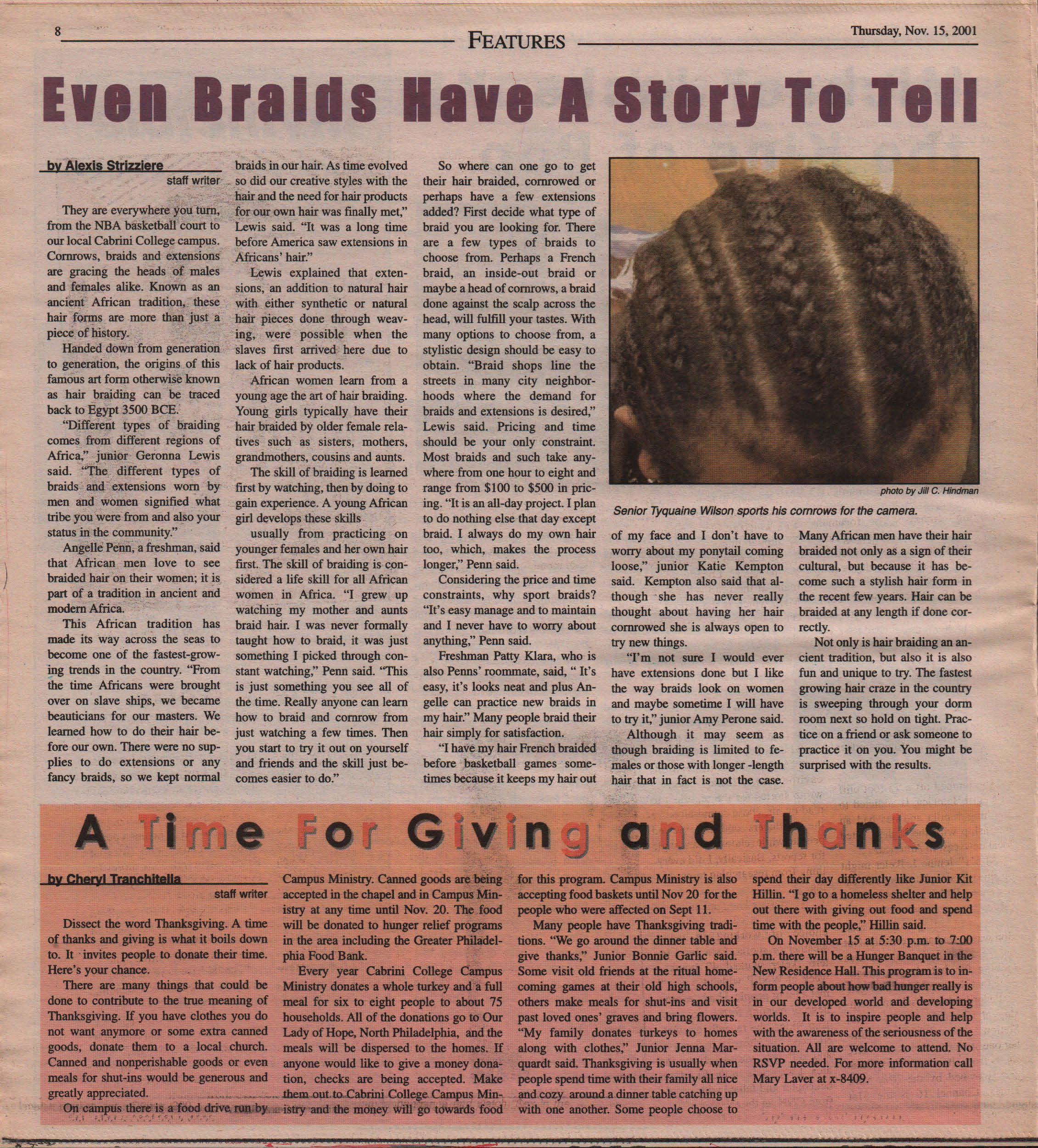
2 minute read
EVIi lrlllls 1111 I St1r1 Tl Tall
by AlexisStrlzziere staff writer
They are everywhere you tum, from the NBA basketball court to our local Cabrini College campus. Cornrows, braids and extensions are gracing the heads of males and females alike. Known as an ancient African tradition, these hair forms are more than just a piece of history.
Advertisement
Handed down from generation to generation, the origins of this famous art form otherwise known as hair braiding can be traced back to Egypt 3500 BCE.'
"Different types of braiding comes from different regions of Africa," junior Geronna Lewis said. "The different types of braids and extensions worn by men and women signified what tribe you were from and also your status in the community."
Angelle Penn, a freshman, said that African men love to see braided hair on their women; it is part of a tradition in ancient and modemAfrica.
This African tradition has made its way across the seas to become one of the fastest-growing trends in the country. "From the time Africans were brought over on slave ships, we became beauticians for our masters. We learned how to do their hair before our own. There were no supplies to do extensions or any fancy braids, so we kept normal braids in our hair. As time evolved so did our creative styles with the hair and the need for hair products for our own hair was finally met," Lewis said. "It was a long time before America saw extensions in Africans' hair."
Lewis explained that extensions, an addition to natural hair with either synthetic or natural hair pieces done through weaving, were possible when the slaves first arrived here due to lack of hair products.
African women learn from a young age the art of hair braiding. Young girls typically have their hair braided by older female relatives such as sisters, mothers, grandmothers, cousins and aunts.
The skill of braiding is learned first by watching, then by doing to gain experience. A young African girl develops these skills usually from practicing on younger females and her own hair first. The skill of braiding is considered a life skill for all African women in Africa. "I grew up watching my mother and aunts braid hair. I was never formally taught how to braid, it was just something I picked through constant watching," Penn said. "This is just something you see all of the time. Really anyone can learn how to braid and cornrow from just watching a few times. Then you start to try it out on yourself and friends and the skill just becomes easier to do."
So where can one go to get their hair braided, cornrowed or perhaps have a few extensions added? First decide what type of braid you are looking for. There are a few types of braids to choose from. Perhaps a French braid, an inside-out braid or maybe a head of cornrows, a braid done against the scalp across the head, will fulfill your tastes. With many options to choose from, a stylistic design should be easy to obtain. "Braid shops line the streets in many city neighborhoods where the demand for braids and extensions is desired," Lewis said. Pricing and time should be your only constraint. Most braids and such take anywhere from one hour to eight and range from $100 to $500 in pricing. "It is an all-day project. I plan to do nothing else that day except braid. I always do my own hair too, which, makes the process longer;' Penn said.
Considering the price and time constraints, why sport braids?
"It's easy manage and to maintain and I never have to worry about anything," Penn said.
Freshman Patty Klara, who is also Penns' roommate, said," It's easy, it's looks neat and plus Angelle can practice new braids in my hair." Many people braid their hair simply for satisfaction.
"I have my hair French braided before basketball games sometimes because it keeps my hair out







